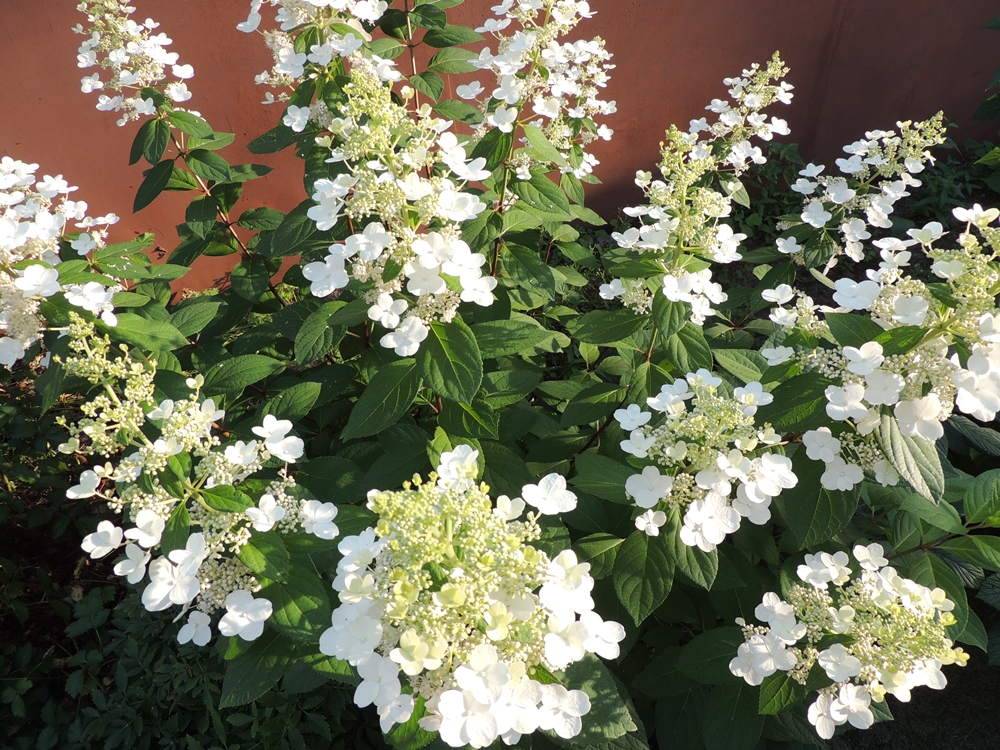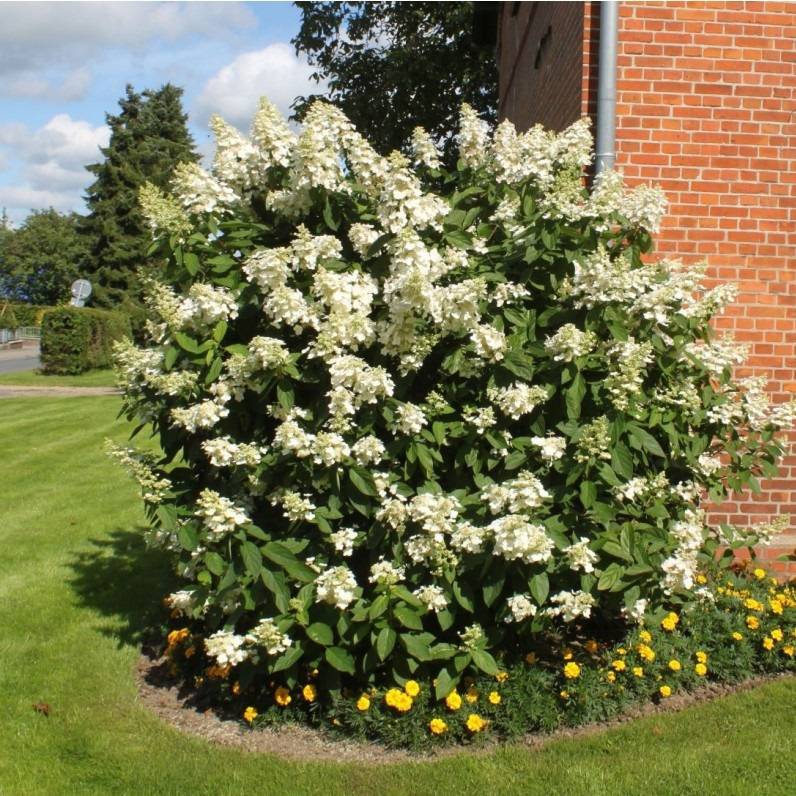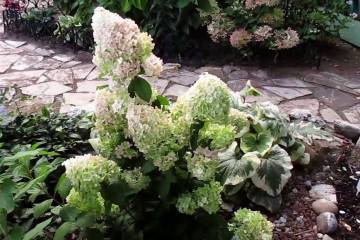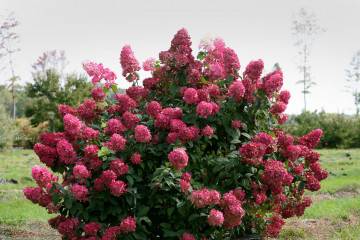Hydrangea Kyushu - description of the variety of panicle hydrangea
Content:
With the onset of spring, the Kyushu hydrangea bush does not stand out among the total mass of greenery in the garden or in the flower bed. But as soon as summer comes, the plant changes. Its magnificent inflorescences attract attention and the Kyushu hydrangea pleases its owner with delightful white inflorescences.
Description and appearance of Kyushu hydrangea
Hydrangea paniculata Kyushu (Latin - hydrangea paniculata kyushu) is a deciduous shrub that grows in a wide variety of soils, excluding marshes and sands.
Describing the variety, the following features should be noted:
- The root system is superficial, but quite spreading. The diameter exceeds the size of the bush in diameter.
- The branches grow upward and slightly to the sides, which allows the bush to form a hemispherical shape with a diameter of about 2.5 m and a little more, under very favorable conditions.
- Leaves are oblong-oval, rich green hue.
- Petioles are brownish red.
- The flowers are small, but gathering in pyramidal inflorescences up to 30 cm long, they form magnificent white clusters with a delicate aroma.
- After flowering, a box with seeds is formed. The seed material itself is quite small and abundant.
- The culture is winter hardiness, which allows it to be grown without problems in the middle lane and northern latitudes.
Planting hydrangeas in open ground
In order for the Kyushu hydrangea to feel as comfortable as possible and to take root faster, it is necessary to plant in early spring. This rule applies to all regions with different climates.
But in the southern parts, you can plant before winter. Temperatures here are not so low, so a young bush will be able to overwinter painlessly. But in this case, it is advisable to use for planting only plants that have formed their own root system, that is, plant layering or already well-rooted cuttings.
The second point that you need to pay close attention to is a suitable place for planting a bush. Hydrangea is quite sensitive to light - it needs intense lighting, but without direct sunlight. It is for this reason that it will be best if this flower is planted in light partial shade.
It is also necessary to consider the proximity of other plants. It is better if these are small shrubs or herbaceous crops. Such a neighborhood will not negatively affect either the hydrangea or its neighbors.
It is also necessary to avoid choosing places where the wind constantly blows. The branches of the bush are fragile and brittle, so young seedlings may simply die.
As for the soil itself, it can be anything for the Kiushu variety, excluding too swampy terrain or an abundance of sand in the soil. Of course, the more nutritious the soil, the more intense and abundant the flowering of the variety will be.
Therefore, during planting, superphosphate (about 30-50 g), nitrogenous fertilizers (20 g), substances containing potassium (15 g), peat soil for alkaline soils and humus, or manure-based fertilizer about 5-7 kg. Planting with these features in mind will give an excellent result - growth will be intense, and the flowering will be abundant and lush.
Reproduction methods
A plant on your site can be obtained in completely different ways:
- Planting seed. But in this case, it will not be possible to get at least a small bush of Kyushu panicle hydrangea soon. The seed method is the most labor-intensive and long-term.
- Cuttings. In this case, it is important to carry out the technologically correct manipulation, ensuring all sanitary conditions. It will take time for a part of the plant to take root.
- Layering is the easiest and fastest way to get a new bush of hydrangea paniculata.
How to care
Despite the fact that the Kyushu hydrangea is quite unpretentious, it still needs to create suitable conditions:
- The bush reacts very well to mulching with needles. It protects the plant from pests and excessive drying out.
- Provide regular watering. It is best to produce it late in the evening or early in the morning. With this bush, it is better to adhere to the rule - an excess of moisture will not harm, and a shortage will destroy.
- The more nutrients are added to the soil, the longer, more colorful and more abundant the hydrangea will bloom. It is advisable during budding and active flowering to make any kind of dressing approximately 2 times in 1 month.
- Provide the shrub with regular pruning. This is necessary not only for better growth, so you can form a suitable bush shape, for example, a bole.
Shrub pruning
Shrub pruning is carried out regularly:
- In the early spring period, it must be performed in order to ensure active growth and release of young shoots.
- In the fall, before wintering, the bush is cut in order to provide it with proper care and comfortable transfer of low temperatures.
- Trimming is carried out according to the presented scheme.
When and how much to water
It is necessary to add moisture in the spring approximately 1 time in 7-10 days. It is necessary to focus on the intensity of precipitation in a particular season.
During the summer period, watering should be increased. This is done so that the buds gain strength and form an open inflorescence.
It is necessary to control the moisture content of the soil, it is better to pour the hydrangea than to add less moisture.
Top dressing
The following fertilizers are used for feeding:
- During the active gathering of green mass, it is necessary to make nitroammofosku, nitrogenous types of fertilizers. This is the period of early spring.
- Once the arrow and buds have formed, it is necessary to use urea and superphosphate. Potassium sulfates can also be used. This will help plant a beautiful, correct flower.
- As soon as the hydrangea has stopped blooming, it needs to provide exclusively sulfates and no nitrogen.
Winter hardiness of the variety
The description of the hydrangea variety Kiushu makes it clear that the plant is winter-hardy. But you need to understand what level of cold it can withstand.
The fact is that in the southern regions and where frosts do not fall to too low levels, the bush can overwinter without additional shelter. But this is only true for an adult plant, whose age is more than 3 years.For young shrubs, you need careful shelter with spruce branches or special material.
If the frosts drop to -20 ..- 30 ° С and persist for a long period, then it is advisable to wrap up adult bushes as well. This will avoid the loss of a varietal bush.
Pest and disease control
The more suitable conditions are created for hydrangeas, the less the likelihood of disease and pest attacks. But if this could not be avoided, then you need to know:
- Kuprozan, Kaptan, Fundazol or Bavistin will help get rid of gray rot;
- from white rot - the same Fundazol, Zuparen;
- copper oxychloride and Ferbam are effective against white spot;
- and iron vitriol or colloidal sulfur will help fight rust.
Observing all the above recommendations and rules for care, you can get an attractive adult plant on your site that will meet all the requirements. And long-term flowering will delight the owners.






















